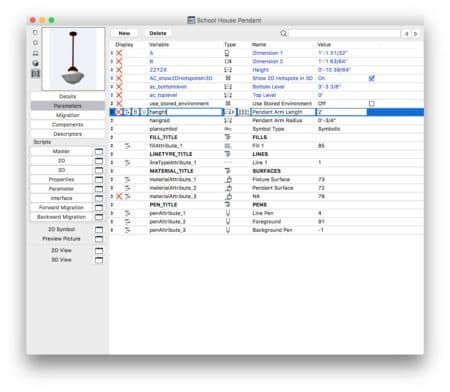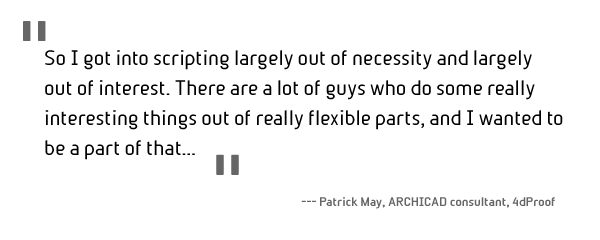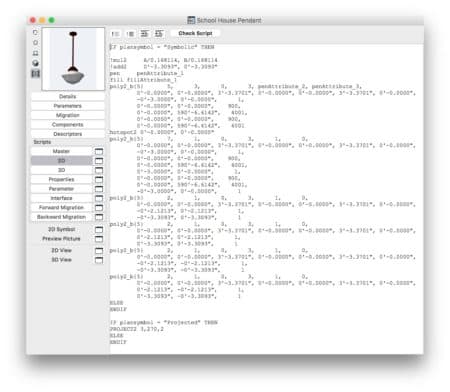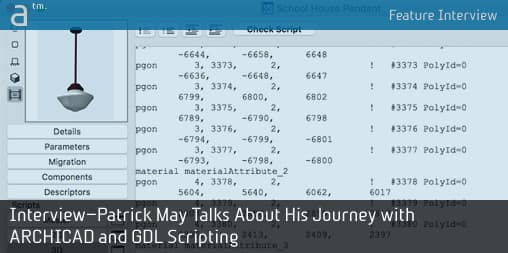Generally speaking, scripting architecture design tools is hard. But it can be made a lot easier and Patrick May appears to have found a pathway to making it so.
So how did he do it and why is his method of value? As one might explain it, chances are high that if his sessions at this year’s 2017 BIMCON were popular it likely had a lot to do with his background of not being a “programmer type.” He will quickly admit that there are far more advanced GDL scripters out there than he.

01 – Patrick May is an ARCHICAD expert and presented at the 2017 BIMCON in Las Vegas. His GDL sessions were popular.
Patrick May, bearded and unassuming, wearing clothes that felt a bit retro and with a steady and quite demeanor, sat as sturdy as a 60-year old Harvard archeology professor before his session at BIMCON. Except, May is an obvious Millennial. I didn’t know where he was from but if I had to take a wild guess I would have said Portland, Oregon.
That turned out to a bit accurate.
A graduate of the University of Oregon, May’s architecture school experience—as the reader will learn below—almost sounds quaint. If he found computing in architecture later than others, he quickly made up for it. Intrigued by his successful approach to GDL learning and his general mastery of ARCHICAD, I spoke to him at length after his session at BIMCON. Here’s what he had to say, about his journey to ARCHICAD and the value he places on mastering GDL (Geometric Description Language).
The Interview
(Architosh) So in the presentation, you said you have been using ARCHICAD for ten years, when did you first start?
(May) Yeah, I started in early 2006. I graduated from the University of Oregon. About five or six months before I graduated I started doing a job search, and I came across a small firm on the Oregon coast; I had never heard of ARCHICAD before that. And I went in for an interview, and they showed me ARCHICAD 8.1, and they handed me a disc and said: “you can play around with this in demo mode and see what you can do.” So I kludged my way through it, didn’t understand it, but got good enough to get the job.
How long did you work there?
I worked there about three years. It was a small firm, mostly residential a little bit of preservation work and we used ARCHICAD, and I learned it; I like to think I mastered it at that point—the three years—and became really proficient at it and that was around 2008 or 2009 when the market just fell out. The next job I got was at a firm as their ARCHICAD expert—they were transitioning from AutoCAD and I came in as their in-house expert trainer and trying to help them roll their projects into ARCHICAD. And that’s what I’ve been doing ever since.

02 – Patrick May presented at 2017 BIMCON a popular session on GDL that aimed to making custom objects for your firm’s libraries easy. Here’s a screen shot of ARCHICAD’s GDL editing environment (parameters). (image: Patrick May, all rights reserved.)
From there I moved onto Walker Warner Architects out in San Francisco. I worked there as—well the design title was Digital Design Coordinator—it was actually kind of a BIM manager lite role where I was their in-house ARCHICAD expert/manager/troubleshooter. I worked there for three years. And then for the last few months, I’ve been on my own as I started up my consultancy called 4dProof and I do ARCHICAD training, consulting, template building, light-weight object development and then just a little bit of freelance work.
My primary work is still with Walker Warner Architects. I’m working as their freelance CAD/BIM manager remotely.
How big is Walker Warner Architects?
Walker Warner—well things can always be in flux, but—they are usually between 40 and 50 people. They have, I believe, 35 ARCHICAD licenses now, so they have a lot of people working on ARCHICAD, and their work is primarily residential work, though they do occasional winery jobs and things like that. It’s fun work, really high-end stuff.
Is your business located in the San Francisco area too?
Not anymore. That’s one of the reasons why I’m working remotely, Walker Warner wanted me as a consultant rather than a salaried employee, and that’s the direction I wanted to go as well. So we moved away from the Bay area when we had our fourth child. We moved back to Oregon, just south of Portland.
So three years is what you are saying it took you to dive in and become an ARCHICAD expert—that’s impressive.
Well, I would say I went from the guy asking all the stupid ARCHICAD questions in that first office to the guy being asked all the questions—probably in about six months. At the time, just being fresh out of school and being eager to learn everything I could and being more adept at learning software at that younger age, it didn’t take quite as long.

Now that I’m specialized in training people in the software I see it’s quite mixed. Some people pick it up quite quickly like I did, and some people take months or even a couple of years to the point where they feel confident and proficient at it.
Did you have BIM training before that?
No, I had not heard of ARCHICAD, or Revit, or of many things. In school I used a little bit of formZ, I used a little bit of SketchUp, I used a little bit of AutoCAD, but primarily I did a lot of hand-drawing and physical models in [architecture] school.
What school again did you say you went to?
University of Oregon.
Wow. A lot of hand drawings and a little bit of technology…
Well, it was back in 2006, and nobody talked about BIM back then. It seemed sort of an aside and on the fridge of what people were looking at. So, it wasn’t brought into schools at the time. At least not at the University of Oregon or any other architecture schools that I knew of. 3D was something that some people did really well, and some people didn’t do it at all. The University of Oregon was great because they didn’t cram anything at you.
And I saw from your presentation today you are a Mac user.
I am a Mac user. I am totally comfortable on both Mac and PC, but I definitely prefer a Mac. I’m looking to get a bit more up-to-speed on PCs because some of the new real-time rendering engines out there are only on Windows at the moment. And I do some work that requires some rendering and ARCHICAD is good for that. But if you want a great rendering you need to go to some of the dedicated advanced rendering tools. And I’ve been looking at experimenting with Lumion and some of the programs like that.
What drew you to GDL? This is your area of expertise now, but you are not a programming type, as you say.
Yeah, I don’t program, and I won’t make any pretense of being a scripting genius. It developed out of necessity. Walker Warner, they are very specific on their needs and what they want within their model and what they want to use that model for. So, in the time I was there in-house, and continually with them now, as an independent consultant with them, it’s a monthly thing where I am re-evaluating the library and building it up, repairing some objects, etc.

03 – ARCHICAD’S GDL environment shown here, with the editing of 3D scripts shown for a pendant light fixture. (image: Patrick May. All rights reserved.)
So they have gone from 150 or so custom objects in their library to having multiple BIMserver libraries, and we may now be up over 1000 custom objects in our libraries. And it is because everything is so custom-built and so high-end that if they specify a faucet, they want to see what that will look like because they will do a high-end quality rendering of that bathroom to make sure that is the right fixture.
So I got into scripting largely out of necessity and largely out of interest. There are a lot of guys who do some really interesting things out of really flexible parts, and I wanted to be a part of that and bring that to Walker Warner’s toolbox. So it wasn’t a job requirement that I knew how to script in GDL, but it has made things easier for project teams.
And at that firm, these are high-end residential projects and do they do them all in full BIM?
Yes. I would maybe say it is the light-end of BIM. They are not scheduling a lot of stuff, but we do a lot of coordination at Walker Warner, we do a lot of IFC work. So we are sending models out to the structural engineer or the metal fab guys, and those guys are building their models around that. And we are doing some 3D coordination now. But it is definitely not a full BIM workflow. We don’t have the BIM protocols; we don’t have the ownership controls of who is doing what.
If you could make GDL better, what would you like to see?
next page: Making GDL Better and More on BIM




Reader Comments
Comments for this story are closed